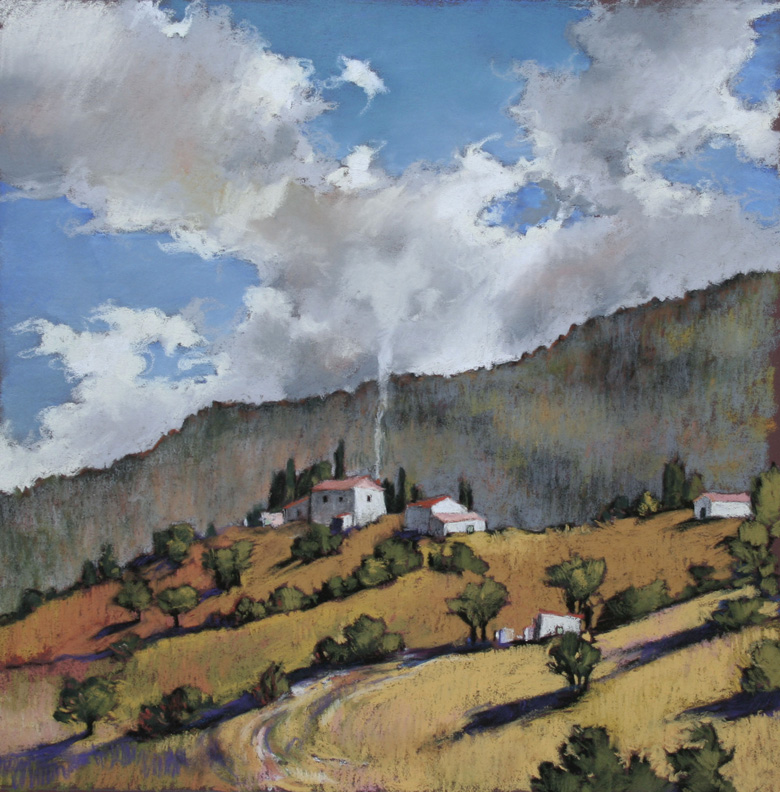My children, who will shortly have both feet planted firmly in adulthood, always had to make do with my accounts of celebrating various festivities in the United States. They never had the chance, until recently, to experience an American Halloween, or Thanksgiving, or a Fourth of July in the United States. It isn’t easy carrying on a tradition in isolation, but I did my best, and I am confident that our bittersweet memories of my attempts to instill American memories in absentia will be fondly remembered.
As Halloween neared every year, I would begin seeking out a pumpkin to carve. Most pumpkins in Italy are the type which are flattish and have loads of thick flesh, and are therefore difficult to carve. But at my special request, the greengrocer would eventually procure me a round one, maybe two, on which the boys and I could practice our creativity. Messes were made. Candy was furtively purchased.
With approaching dusk, we would prepare, letting the boys dress up as they saw fit; a cowboy, or a ninja, or some hybrid version of a soldier. I used a small bungalow which served as my studio, about forty yards from the house, and I would position myself there with a bowl of candy while my husband stayed at the main house with his bowl. Lights were turned off, and the jack-o-lanterns glowed as the boys rushed breathlessly back and forth in the dark, gradually filling their bags with candy and treats. The doorbell must be rung each time! What a surprise to find mom or dad again every time the door opened, and my boys were nothing if not sporting about the absurdity of this little farce. After all, there was candy! Of course this artificial creation of Halloween filled me with a kind of desperate nostalgia, because during these years I simply did not know if they would ever have the genuine experiences which, for me, had been such a memorable and integral part of my childhood. And they were growing up fast.
There was general consternation among our friends because back in those years, most were not familiar with Halloween. In the early nineties, when the idea was beginning to catch on, the few kids who dared to ring buzzers and ask at condominiums and apartments around town were often met with scowls and outright hostility. Children would have to be careful that their requests of “dolcetto o scherzetto” weren’t met with a shower of profanity, a swinging broom, or even pebbles thrown from a balcony! Kids were often chased away by angry old-timers, scandalized by the encroachment, yet again, of America on their sound Italian traditions.
This is changing rapidly today, as Halloween is celebrated with great gusto. The population of the town is divided unevenly between the many who love an excuse to party for any reason, and the few who resent “commercial holidays which exist only to make money” being foisted upon them by stores. The tremendous rise in Chinese imports may also have played a role in the speed at which Halloween was introduced. And of course there is America, ever present, always ready to offer another “americanismo” for no good reason. St. Valentine’s day has been borrowed, repackaged by American culture, and re proposed complete with cards, heart-shaped chocolate boxes, and petulant girlfriends expecting to score something shiny. If I could express my point of view simply, I would say that their resentment is equaled by my own at having had “my” traditional holiday hijacked for these very same, highly commercial, reasons. I cannot easily accept the idea that the festivity was somehow forced upon an innocent culture. Now, the festivities of Halloween play a bigger role every year in Italy, with themed parties, invitation-only balls, and children ringing doorbells. It has been adopted in record time, and yes, sales are good. Fewer die-hard traditionalists object every year to its observance. Jack-o-lanterns shine from windows and the balconies of apartment blocks.
It is a strange feeling, as an isolated American, seeing the adoption and growth of a traditional holiday, as it morphs into something similar yet different, tailored and modified to fit another culture. I suppose Thanksgiving is safe from being franchised, as I don’t think the Italians could justify celebrating the survival of Protestants in the New World, although the Cristoforo Colombo connection is always a possibility. Hundreds of thousands of immigrants to the United States must have a special feeling in their hearts about it I am sure. Every year I have prepared my best version of turkey and dressing, pumpkin pie and whipped cream. It is amusing to me that there are friends in Bernalda who insist I make them up a plate of this Thanksgiving food every year because they love the unusual flavors. At Halloween, I have been consulted about pumpkin carving and the best methodology for covering the most territory during the evening. My sons instructed their friends about how gaining entrance to one large condominium could make or break the night’s haul.
I think my boys have absorbed these traditions seamlessly, and they happily participate now as if they had been living as Americans all along. I suppose I can say that having done my best to instill these family traditions in my kids, it will be up to them now to carry on, wherever they may decide to live. I foresee them bringing the Befana to Christmas, celebrating their saints’ name days, and observing April 25, the liberation of Italy from the fascists, as an important date for both their cultures. Along with Halloween, Thanksgiving, Saint Patrick’s Day, Easter’s various manifestations, all are important to a solid understanding of our cultural traditions. Hopefully strong roots make for a sturdier tree.
“Out of the Cage” mixed media on paper, 2000




